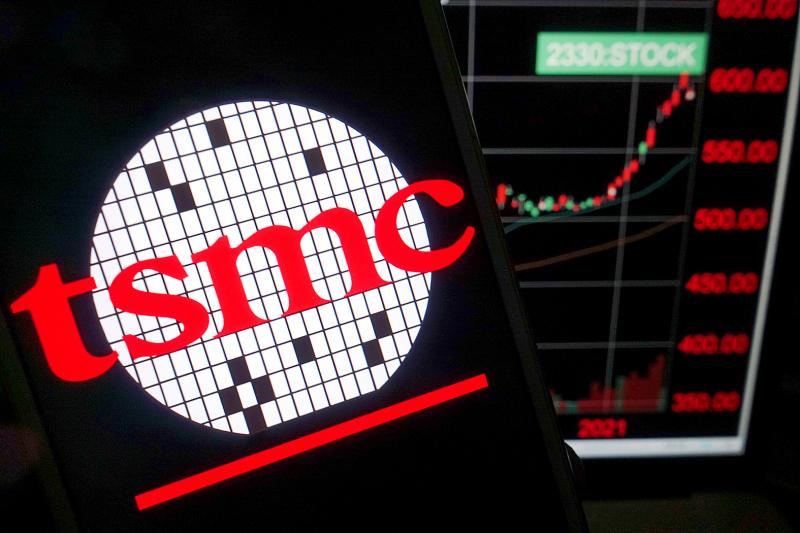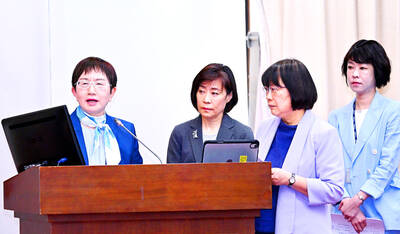Taiwan Semiconductor Manufacturing Co (TSMC, 台積電) is considering building an advanced IC packaging plant in the US following a massive investment to set up a wafer fab in Arizona, Nikkei Asia reported.
TSMC was considering the plant in response to “Washington’s desire to bring more of the tech supply chain onto home turf,” the report said.
TSMC increasingly faces the need to expand in the US, which accounts for about 62 percent of its total sales, Nikkei Asia said, citing three sources who declined to be named.

Photo: CNA
The potential US plant would be equipped with the latest 3D stacking technologies to arrange chips with different functions in one package, it said.
US EXPANSION
TSMC last year announced that it would invest US$12 billion to establish a wafer plant in Arizona, the company’s first new fab outside Taiwan in more than two decades. The facility is under construction.
The plant is to use the chipmaker’s 5-nanometer process, its latest technology, which has been used for mass production at its Taiwan fabs since the second quarter of last year.
TSMC is also developing 3 and 2-nanometer processes, with commercial production using the new technology to start next year.
The Arizona facility would make chips for Apple Inc’s newest generation of iPhones and Mac computers.
In April, TSMC chief executive officer C.C. Wei (魏哲家) said that construction at the plant was on schedule.
Production at the facility is to start in 2024.
TSMC had acquired an additional plot in the US that could be used for expansion in the country, depending on client demand, operations and cost efficiency, Wei said.
The US market, as well as other global markets, is heavily dependent on chips from Taiwan, raising concerns in Washington over supply chain risks, Nikkei Asia said.
This was because of China’s threats to use military force against Taiwan, it said.
For the Arizona plant, “the most certain part is the initial capacity of 20,000 wafers per month,” Nikkei Asia said, quoting one of the sources. “TSMC surely has further expansion blueprints.”
‘CAUTIOUS’
“The company is cautious not to make commitments too early, as there are a lot of uncertainties that need to be taken into consideration, including geopolitical factors,” the report said.
TSMC is planning to expand the plant’s capacity to 120,000 units per month, Nikkei Asia said.
Only four of TSMC’s wafer fabs have a monthly production capacity of more than 100,000 units, the report said, adding that the four plants are in Taiwan.
IC packaging “is also highly centralized in Asia, and is an area where Washington wants more self-reliance,” the report said.
“Once viewed as relatively unsophisticated, packaging is becoming more important and innovative as the pace of technological advances in chipmaking slows and chipmakers try to eke out more performance,” it added.
TSMC has moved aggressively into high-end IC packaging and testing to provide one-stop shopping services for wafer clients who also require advanced 3D IC packaging and testing technology.
TSMC is building an advanced IC packaging plant in Miaoli County, where it is to start production next year for clients including Advanced Micro Devices Inc and Google, Nikkei Asia said.
TSMC operates advanced IC packaging and testing plants in Taoyuan, Hsinchu, Taichung and Tainan.

‘SWASTICAR’: Tesla CEO Elon Musk’s close association with Donald Trump has prompted opponents to brand him a ‘Nazi’ and resulted in a dramatic drop in sales Demonstrators descended on Tesla Inc dealerships across the US, and in Europe and Canada on Saturday to protest company chief Elon Musk, who has amassed extraordinary power as a top adviser to US President Donald Trump. Waving signs with messages such as “Musk is stealing our money” and “Reclaim our country,” the protests largely took place peacefully following fiery episodes of vandalism on Tesla vehicles, dealerships and other facilities in recent weeks that US officials have denounced as terrorism. Hundreds rallied on Saturday outside the Tesla dealership in Manhattan. Some blasted Musk, the world’s richest man, while others demanded the shuttering of his

Taiwan’s official purchasing managers’ index (PMI) last month rose 0.2 percentage points to 54.2, in a second consecutive month of expansion, thanks to front-loading demand intended to avoid potential US tariff hikes, the Chung-Hua Institution for Economic Research (CIER, 中華經濟研究院) said yesterday. While short-term demand appeared robust, uncertainties rose due to US President Donald Trump’s unpredictable trade policy, CIER president Lien Hsien-ming (連賢明) told a news conference in Taipei. Taiwan’s economy this year would be characterized by high-level fluctuations and the volatility would be wilder than most expect, Lien said Demand for electronics, particularly semiconductors, continues to benefit from US technology giants’ effort

TIGHT-LIPPED: UMC said it had no merger plans at the moment, after Nikkei Asia reported that the firm and GlobalFoundries were considering restarting merger talks United Microelectronics Corp (UMC, 聯電), the world’s No. 4 contract chipmaker, yesterday launched a new US$5 billion 12-inch chip factory in Singapore as part of its latest effort to diversify its manufacturing footprint amid growing geopolitical risks. The new factory, adjacent to UMC’s existing Singapore fab in the Pasir Res Wafer Fab Park, is scheduled to enter volume production next year, utilizing mature 22-nanometer and 28-nanometer process technologies, UMC said in a statement. The company plans to invest US$5 billion during the first phase of the new fab, which would have an installed capacity of 30,000 12-inch wafers per month, it said. The

Minister of Finance Chuang Tsui-yun (莊翠雲) yesterday told lawmakers that she “would not speculate,” but a “response plan” has been prepared in case Taiwan is targeted by US President Donald Trump’s reciprocal tariffs, which are to be announced on Wednesday next week. The Trump administration, including US Secretary of the Treasury Scott Bessent, has said that much of the proposed reciprocal tariffs would focus on the 15 countries that have the highest trade surpluses with the US. Bessent has referred to those countries as the “dirty 15,” but has not named them. Last year, Taiwan’s US$73.9 billion trade surplus with the US